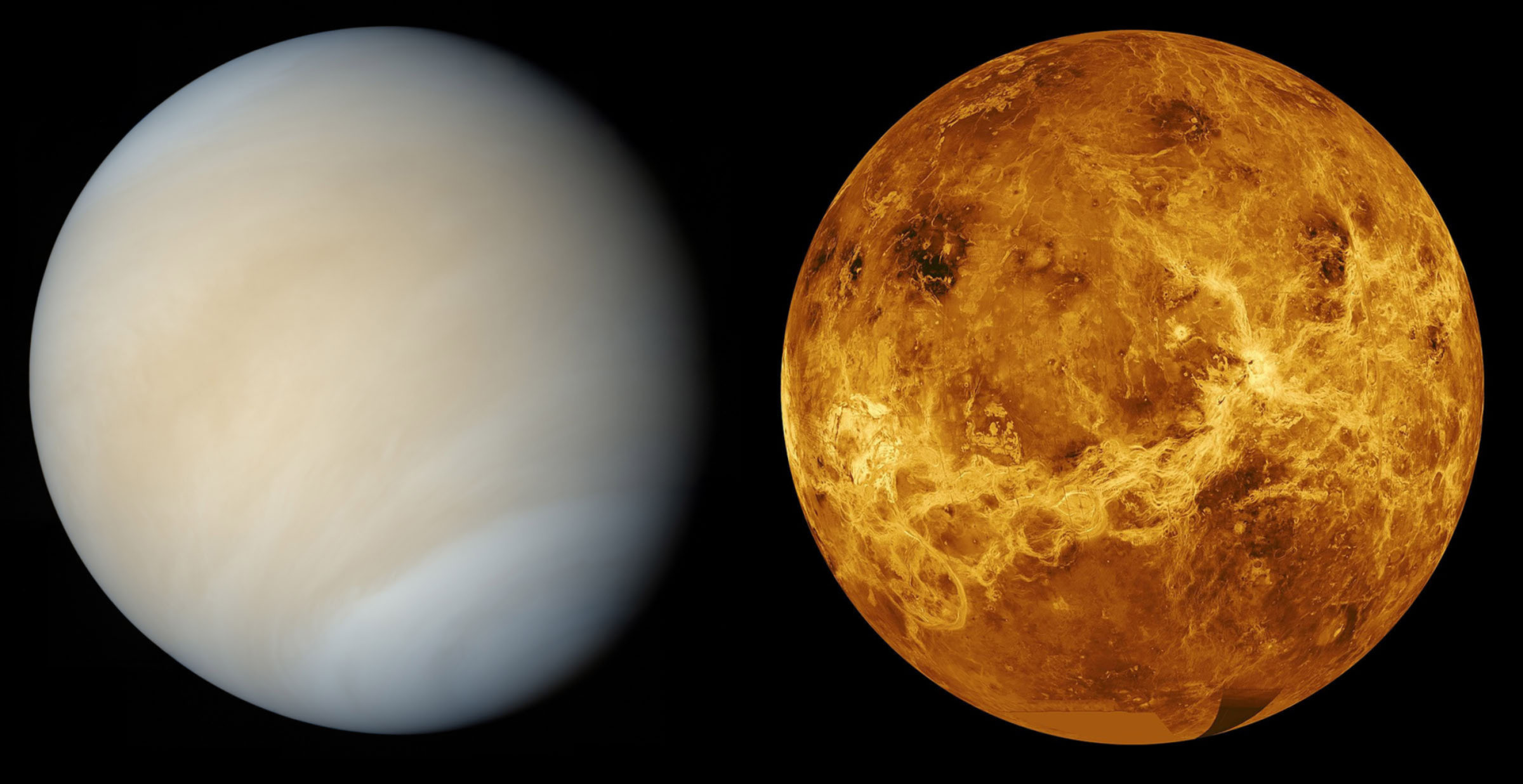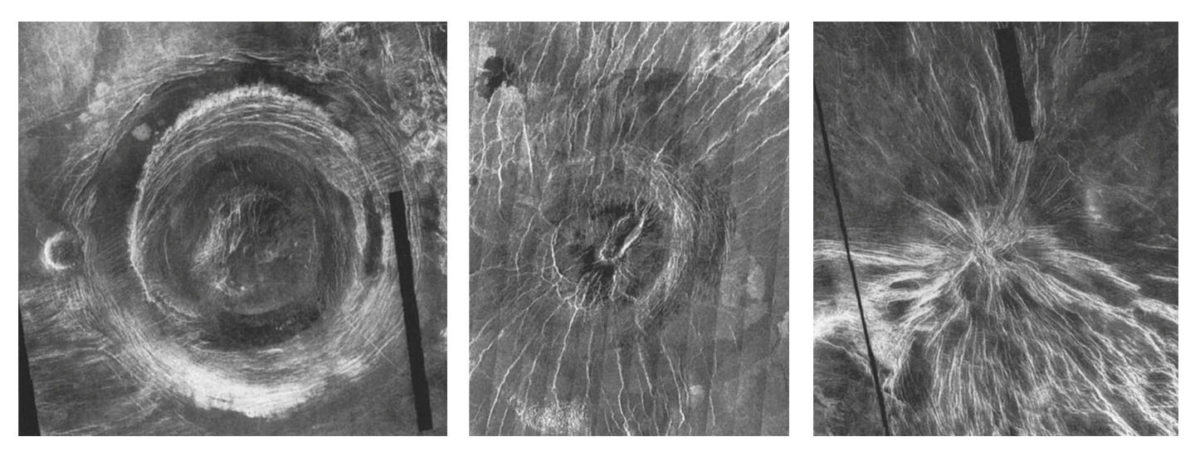Adeene Denton • Aug 14, 2018
The Venus controversy
A lack of new missions keeps scientists guessing on what shaped the planet’s surface
What happens when scientists fundamentally disagree about planetary bodies? It happens more often than you might think. These disagreements are often fundamental: How did the Moon get its craters? Could Mars have sustained life? The controversies of our field often answer themselves when more data is added, but sometimes more data is a long time coming. Often, more data leaves us more confused than before! In the case of Venus, the entire history of the planet has been up for debate for about 40 years, ever since the first Soviet probes transmitted images back from the surface. In particular, planetary scientists are fascinated by the parallel development — and divergence — of Venus and Earth, the two most similar rocky planets.
Venus: It's different from Earth on the surface
Venus is an Earth-like planet. Both planets have similar masses, sizes, and densities—Venus is just a little closer to the Sun.
However, despite its numerous bulk geologic similarities with Earth, Venus has a surface unlike anything terrestrial geologists have ever seen. We learned from the Soviet Venera landers in the 1970s and the Magellan orbiter in the 1990s that Venus’ craters, volcanoes, and topography are all dramatically different than those found on Earth.
Unfortunately, Venus’ thick atmosphere prevents us from seeing the surface very well. We don’t have optical images except for those taken from the Venera landers. Magellan’s radar maps are global, but their resolution is low (101 to 250 meters per pixel). Today, they remain the first and best reconstruction of the contemporary Venusian surface.
Compare that to Mars, where the Context Camera on the Mars Reconnaissance Orbiter has achieved global coverage at 6 meters per pixel. The Lunar Reconnaissance Orbiter’s Narrow Angle Camera has captured the majority of the Moon at 0.5 meters per pixel. Similarly, we have far better topographic data for the Moon and Mars than we do for Venus. Only the Earth’s ocean floor is as poorly imaged as Venus, with less than 10 percent of it mapped in detail. Venus, shrouded in clouds, and the ocean floor, insulated by water, remain the few places in the Solar System that are currently out of our technological reach.

Volcanoes seem key
Eighty percent of Venus’ surface is covered by volcanic features—a similar amount to Earth if we count the basaltic ocean floors—and yet volcanism itself seems to have been a very different process, potentially with very different timing, just one planet over. Venus’ volcanoes are impressive both in number and size, particularly in comparison to Earth, where the number of observed volcanoes numbers in the low thousands. On Venus there are huge fields of up to 7,000 shield volcanoes concentrated together as well as massive, individual volcanic edifices up to about 1000 kilometers in diameter (for comparison, the largest volcano on Earth today, Mauna Loa, is about 120 kilometers across). There are also features on Venus that geologists think are volcanic but whose surface morphology and fracture patterns are unlike any seen on Earth. These include concentric-ringed coronae, spidery arachnoids, and star-like novae.

The supply of magma from the interior of the planet controls where and how volcanic features form. The number, variety, and size of Venus’ volcanic structures has led researchers to suggest that very large magma reservoirs fueled them. Such large reservoirs could have accumulated from material delivered by multiple mantle plumes (otherwise known as hot spots) rising from deep in the Venusian mantle. Why did Venus produce so many plumes? How did such a large magma reservoir accumulate before the eruptions? We don’t know.
The locations of the volcanoes are another clue that something different may be happening inside Venus. On Earth, most volcanoes form along the boundaries between tectonic plates. On Venus, volcanic features are distributed globally in a pattern that seems almost random (though it’s actually not quite random). The volcanoes that we can see on Venus today didn’t happen because of plate tectonics. It’s possible that Venus never had Earth-like plate tectonics at all, which begs the question – what else can drive volcanism on a planet, and how did it get so colossal?
Impact craters are another key
Venus also doesn’t do impact craters the same way the Earth or the Moon do. Like volcanoes, impact craters are distributed nearly randomly on its surface. What’s weirder is that almost all of them (85 percent) appear pristine, apparently unmodified by the massive amounts of volcanic activity recorded in the surface features around them. Thus, these craters likely formed after most of the volcanic activity on the surface died down. There are also not very many impact craters, which suggests a youthful surface (on average, 200 to 700 million years old), unlike the ancient surfaces of the Moon, Mercury, and Mars.
What could make a young surface, covered with volcanoes and pristine craters? Some scientists have suggested that Venus’ old impact craters were erased by a global volcanic resurfacing event, a massive catastrophe that left it with no visible impacts craters at all. Other scientists disagree.
Different surfaces, different interiors
The differences in Earth and Venus’ surfaces indicate they are also different on the inside. The surface features of Venus are related to volcanism and/or fracturing from internal stress. Volcanism and tectonism are both driven by the circulation of material (and heat) within a planet’s interior. Therefore, scientists think such circulation inside Venus has developed differently from what happens inside the Earth.
Trying to make sense of it all: catastrophic versus steady state
If the entirety of the Venusian surface was replaced by a worldwide volcanic event, how long did it take? Was it dramatic and catastrophic, completed in a hundred thousand years or less, or could it have been an incremental, yet still globally effective process stretched over more than a hundred million years? The planetary geology community does not agree on this point. Different scientists have proposed different volcanic resurfacing models, all of them consistent with the young impact cratering record but disparate in their approach to explaining the evolution of the planet. These models act as well-developed, complex hypotheses, incorporating each of the necessary geologic processes from the bingo card of what’s possible in planetary science. However, because geologic processes can be as variable as the planets in our solar system, there’s a lot of room for interpretation.
For scientists discussing Venusian history, there are two extreme points of view: catastrophic and steady-state. These terms refer to the primary difference between the two models, which is how long the resurfacing of Venus actually took. The catastrophic resurfacing model suggests that planetary resurfacing on Venus occurred through infrequent, planet-wide volcanic events, large enough to bury all earlier material. In other words, resurfacing was a near-instantaneous change to Venus relative to the slow flow of geologic time.
Steady-state, on the other hand, implies numerous smaller, discrete processes, stretched out across time. For Venus, the steady-state model posits more frequent resurfacing episodes, more similar to the pace of volcanism on Earth, that obliterate older craters at the local scale over much longer timescales. If the location and timing of the volcanism work out, a slower pace might still yield a young age for the surface overall.
Hypothesis testing, and solving the tectonic puzzle
Which model is correct—or, at least, closer to correct? To answer that question, researchers first have to understand what drives Venus' volcanoes. On Earth, volcanism happens because of plate tectonics. However, there does not appear to be plate tectonics on Venus. Without actively moving plates, the production, movement, and eruption of magma is likely a fundamentally different process on Venus than it is on Earth.

New crust on Earth gets built horizontally, thanks to the lateral motion of the spreading centers. Without such spreading, new crust on Venus has to be built vertically. On Venus, the crust gets thickened on the top by volcanism and on the bottom by slowly cooling magma reservoirs. This process builds a thick, and correspondingly strong, basaltic crust that grows thicker over time. Such a strong crust resists deformation, even if Venus' mantle flows and circulates under the crust like Earth's does. Without deformation, plate tectonics can't start.
Plate tectonics plays a crucial role in Earth's geology. The churning of the solid rocky mantle, with hot material rising from deep in the interior and causing volcanic eruptions at the surface, efficiently moves heat from deep within Earth out of the planet and into space. On Venus, without plate tectonics, heat has no quick route out of the interior. The planet generates internal heat in the same ways that Earth does: by freezing of the core and radioactive decay. But the heat has nowhere to go. It builds up, and the overheating mantle starts to melt. If there continues to be no heat release, it’s possible for large sections of the mantle to melt relatively quickly, generating a massive reservoir of magma at the crust-mantle boundary that then erupts. Many more specific mechanisms have been proposed to produce global volcanic catastrophe, but each has one basic idea in common: massive, all-encompassing destabilization of the Venusian mantle, producing a correspondingly massive response—the release of all that magma as volcanism—to return things to business as usual. When this happens, Venus returns to being a slowly cooling, mostly stagnant planet. It may have cooled to the point where such a resurfacing event may never happen again. This is the catastrophic resurfacing model.
The catastrophic resurfacing model is loud, flashy, and exciting. However, scientists are prone to asking: what if? What if things were a bit more stable? Proposers of the steady-state hypothesis questioned the necessity of catastrophe, given the diversity of volcanism on Earth. The steady-state approach hinges on a Venus that is more compatible with Earth on the inside and the outside, in which volcanism is produced intermittently in discrete locations. More regular volcanism could bury sections of the surface at random, driven by more typical variations in circulation of the mantle. In this model, however, there’s no reason for volcanism to stop—and it had to stop in order for the craters observed by Magellan to remain pristine.
It’s difficult to reconcile the steady-state approach to volcanism with a mechanism that also stops the volcanism so quickly. The catastrophic resurfacing model, meanwhile, effectively stops itself once the mantle runs out of excess heat, which is a primary reason that this model has become the currently favored scenario in the scientific community. In the years since Magellan, growing consensus suggests that the surface of Venus that we see today was indeed the result of a dramatic outburst of volcanism, which in turn “shut off” volcanism going forward.
Future directions
While the majority of the community currently favors the catastrophic overturn hypothesis, there are still some problems. We don't understand how important Venusian geologic features like the coronae, arachnoids, and novae formed (pictured above), so we can't use them to differentiate between the catastrophic and steady-state models. We also don't know the composition of Venus' crust, mantle, or lavas, which is crucial to understanding how the planet’s magma flows and how much heat it carries.
We need another mission. Will we one day truly understand how Venus' resurfacing occurred? Only time (and federal funding) will tell.
Support our core enterprises
Your support powers our mission to explore worlds, find life, and defend Earth. You make all the difference when you make a gift. Give today!
Donate

 Explore Worlds
Explore Worlds Find Life
Find Life Defend Earth
Defend Earth

